7 Breeding methods
Fuchsia propagates by cuttings, leaves, seeds. Basically, the reproduction of fuchsia is carried out in the first way. The best time for this is spring. For this purpose, a young shoot is chosen on the plant, the length of which should be 10–20 cm. In its lower part, all leaves are removed, and the upper ones are cut in half.
The cutting does not yet have its roots, so the leaves begin to draw out all the moisture from it, not allowing the root system to form. It is placed in a jar with settled water and covered with a translucent bag on top. Roots appear in 5-10 days. After 2-3 weeks, the cutting is planted in a prepared pot with a nutritious soil mixture.
Another option for grafting is planting directly into the prepared substrate. It can be sphagnum, vermiculite, perlite, peat tablet. The stalk must be placed in a container with a lid or in a greenhouse to create a greenhouse effect, since such rooting requires high air humidity. After the roots appear, the greenhouse is opened slightly so that the seedling gradually gets used to indoor conditions.
You can propagate fuchsia with a leaf. A healthy leaf is cut off together with a handle and buried a centimeter into wet perlite, after which it is covered with a jar. In conditions of high humidity, the required temperature and with daily spraying, a miniature rosette of leaves quickly develops at the base of the petiole. When it gets stronger, it is separated from the leaf and planted in a separate pot with a nutrient mixture.
Quite rarely, fuchsia is propagated by seeds. This can only be done by experienced flower growers or breeders, since this is a very time-consuming procedure. First, anthers are removed on the selected flower, which has not yet blossomed. After that, the pollen of the fuchsia variety that needs to be grown is applied to the stamens and stigma of the pistil. The bud is neatly wrapped with a piece of gauze or put on a fabric cover. In this form, the flower should stand for several weeks until the fruit ripens.
The ripe fruit is removed from the stem with tweezers, carefully cut and the seeds are taken out. It is recommended to dry them for several days, after which they are planted in tall containers with a lid. They are sown on the wet surface of a substrate consisting of coarse sand and peat. You should not fill in the seeds, but you just need to press them down with your fingers. The lid is closed and the container is placed in a well-lit area for germination.
The temperature should be within + 18 ... + 22 degrees. The greenhouse should be regularly ventilated and periodically moistened with settled water. Shoots appear in 2-3 weeks. After another 1.5–2 months, young plants dive into separate pots and watered abundantly. In the future, they need to be looked after like adult plants.
How to plant correctly
In addition to rooting the cuttings in the ground, there are other ways to propagate fuchsia at home. You can plant them in peat tablets, in a glass of water, in perlite.
How to root cuttings in peat tablets
A good result is obtained by rooting cuttings in peat tablets. Having carried out the cuttings of fuchsia and rooting the plant in this way, you can be sure that the sprout will definitely take root and will grow rapidly in the future.
Planting stages:
- Soak a peat tablet in water for 10-15 minutes.
- Cut off the stalk, stepping back 1 cm from the bottom pair of leaves.
- The leaves of the plant can be left, but the largest ones are best cut in half.
- Plant it in swollen peat so that the lower knot remains visible.
- Cover the plastic container with polyethylene.
There will be enough moisture for the appendage, so you do not need to water it, but you will have to remove the film for 10-15 minutes for airing.
Important! Before planting, the lower cut of fuchsia must be treated with a plant growth stimulator.
Usually the stalk sprouts 2-3 weeks after planting. But deviations in one direction or another are possible. As soon as the first leaves appear, the film should be removed, and the plant should be watered regularly, avoiding drying out.
How to root cuttings in a glass of water
How to root fuchsia in water with 100% germination guarantee? To do this, you should know what time of year it is best to do it. This breeding method is best used in March-April or September-October. Then you can count on a positive outcome. The indoor climate (not hot or cold) at this time will have a positive effect on the cuttings.
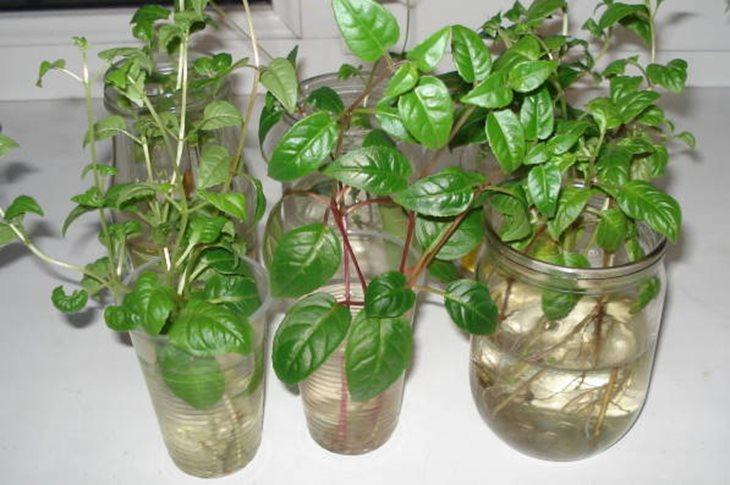
Cuttings in a glass of water
The procedure is as follows:
- Pour cooled boiled water into a glass.
- Add 1 tablet of activated carbon.
- Cut off all the leaves from the cutting, except for the top one.
- Dip it in water, cover with plastic wrap on top.
The first roots should appear on the 4-5th day, and when they reach 2-5 cm, the plant can be transplanted into a pot.
Important! The air temperature in the room during the germination of the roots should not fall below 20 degrees.
How to root fuchsia cuttings in perlite
After successfully grafting fuchsia, you can try to root it in perlite. The actions are as follows:
- Pour perlite into a plastic cup.
- Fill with water and place the handle in a glass at a 45-degree angle.
- Make a greenhouse by covering with a plastic bottle or plastic bag.
- Wait for the roots to appear, and then transplant them into pots with soil.
The improvised greenhouse should be exposed to light, but not in direct sunlight. From time to time, the bottle or bag needs to be removed to ventilate the sprout. If necessary, you can spray the soil around the cutting with water.
Important! The roots of the cutting are thin and easily vulnerable, so you should take it out of the perlite as carefully as possible so as not to damage it.
How to transplant cuttings
After the process of growing the roots is completed, fuchsia should be propagated by transplanting the cuttings into pots. The containers chosen for transplanting should not exceed the earthen lump of sprout with roots by more than 2 cm. It is better to purchase soil for flowers in the store: universal or for violets.
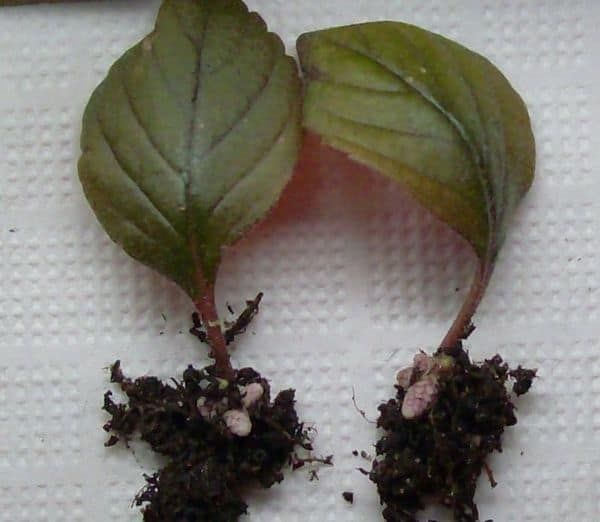
Transplanting cuttings
The stalk with roots must be transplanted into a pot and covered again with a greenhouse, so that the plant can more easily endure stress. You can leave the bag on top so that the air is constantly ventilated.
If the sprout feels good, then after a week the greenhouse can be removed completely. If the fuchsia is moping and looks lethargic, then you need to spray it with water, inflate and tie the bag on top. Keep the sprout in such conditions until the situation improves for the better.
How to grow a flower: step by step instructions
- You need to choose a pot, soil and fertilizer. To get started, stop at a small pot made of ceramic, about 10x10 in size.
- Pick up the soil - you can buy a universal mixture by adding a little sand to it, or mix your own turf, peat and sand in a 3: 2: 1 ratio.
- The first feeding also needs to be introduced simple - the soil with the addition of nitrogen is perfect for starting flower care.
Read more about the rules for growing room and garden fuchsia here.
Seed preparation and germination
Fuchsia seeds can be purchased at any gardening store. Sowing seeds is best in February.
Before sowing, the soil must be moistened with a solution of potassium permanganate, from a spray bottle.
When planting, seeds do not need to be buried deep in the ground - it is enough just to slightly press the seed: for good germination, the plant needs light.
Further it is necessary:
- cover the pot with transparent cellophane or film;
- put on the windowsill;
- monitor temperature and moisture.
If all actions are performed correctly, after 3-4 weeks you can expect the first small shoots to appear.
During this period, it is very important to lift the cellophane, removing the concentrate. After germination, it is recommended to remove the cellophane for a longer time to adapt the plant to indoor conditions.
Care
When the soil dries up, you need to moisten it with a spray bottle, spraying the soil around the sprout. Water for irrigation should be separated, at room temperature.
The ambient temperature for proper growth should be in the region of 18-22 ° C.
Constant lighting should provide the sprouts with light well, while it is better to protect them from direct sunlight. The best thing is to put the pot on the windowsill.
Sprouted sprouts after the appearance of the first leaves need to be periodically sprayed with a small amount of water, it can be the same that is used for watering. Spraying 1-2 times a week will provide the required level of humidity.
Fuchsia varieties with photo
At home, hybrid fuchsia varieties are most often grown. They are in the form of a shrub, semi-shrub, small tree. Fuchsia flowers of all shades and shapes cannot but bewitch. Fuchsia hybrid species have double flowers, bright colors. There are plant species with very large flowers.
In everyday life, Fuchsia is not very picky, so even a novice florist can start it. When choosing a plant for an apartment, be guided by your taste. Fuchsia will fit into any interior design.
Three-leaf fuchsia
Three-leafed Fuchsia resembles a bush up to 60 centimeters in size. The plant grows in breadth, so it is convenient to grow it in a hanging basket. Fuchsia leaves resemble an egg, the length of the leaf is 8 centimeters. Above the leaf is reddish-green, below it is brownish-reddish. There is a small fluff along the veins of the leaf.
The flowers of this Fuchsia species resemble a bell. They gather in inflorescences in several pieces. The shade of the inflorescences is usually orange-reddish. Fuchsia blooms from May to September. With proper care, the flowering period can be extended.
The plant is used to create flower arrangements. You can see Fuchsia in boxes on the balcony, or in the living room (here she is planted in hanging baskets). What this Fuchsia looks like, varieties with photos can be seen in our article or in the catalogs of flower shops.
Magellanic Fuchsia
An evergreen shrub that grows up to 3 meters in height. Fuchsia is used to decorate shop windows, glass, arches. The leaves of the plant are up to 4 cm in size, along the veins have fluff. The color of the leaves is usually purple. The plant blooms all spring and until autumn. Flowers can be single or collected in inflorescences of 4 pieces.
Magellanic Fuchsia is not afraid of low temperatures. If you cut it to 15 cm and cover it with fallen leaves, it can overwinter on the balcony. Usually the plant is taken into the house, choosing the coldest place for it. Watering during the dormant period of the plant should be rare.
Lying Fuchsia
A creeping plant that can be used for pots, flower arrangements, in ampels. The flowers of the plant are directed upward, as if reaching for the sun. Shades of flowers can range from pink to orange. The plant blooms with lonely flowers all spring and autumn.
Sparkling fuchsia
The plant grows in up to 2 meters. It has giant leaves (length 20 cm, width 12 cm) with jagged edges. This Fuchsia has reddish stems and bears fruit. The berries of the plant are edible, collected in a brush.
Sparkling Fuchsia is used in flower ensembles and blooms from June to late August.
Graceful fuchsia
She is called the sister of the Magellan fuchsia. In nature, it can grow up to 3 meters. If grown indoors, fuchsia is only 1 meter tall. The flowers of the plant are drooping, sit on thin, practically invisible stalks. Very beautiful, large in size.The plant blooms from spring to late autumn.
Bolivian fuchsia
The height of an ornamental plant reaches 1 meter. Flowers are collected in bunches. The flower stalks are simply huge (up to 30 cm), flowers gracefully hang on them. Plants can be grown in a warm room, it does not like cold temperatures. Bolivian fuchsia blooms from early March to late April.
Thin Fuchsia
At home, it grows up to 3 meters in height. Fuchsia can be trimmed so that it grows in breadth instead of stretching upward. Fuchsia leaves have a reddish tint. The plant blooms from July to late September. Flowers are collected in brushes, they are drooping. Hang on very thin and long peduncles. The shade of colors can be magenta or violet.
Thyroid Fuchsia
The plant has long and slender flowers, collected in clusters. Fuchsia blooms from early July to late September. The shade of flowers is pink, violet, purple. Fuchsia grows up to 3 meters in height. If you cut it off in time, it grows up to 1 meter. It is used to create flower arrangements in greenhouses, in the office it can be used to decorate a reception desk or an entrance arch.
Bright red fuchsia
This type of fuchsia blooms from April to the end of October. The plant has thin shoots, red flowers with purple accents. Oval leaves are on a short root. Bright red fuchsia is a very beautiful plant. It can be grown both in a private apartment and in an office.
Fuchsia varieties and types
A large flowering bush in a container, a stem or ampelous fuchsia will decorate any veranda, terrace or lawn, it is only important to choose the right variety and place. The most famous fuchsia in our country is beautiful fuchsia (Fuchsia speciosa), it is also hybrid (Fuchsia hybrida) - the result of crossing Fuchsia fulgens x Fuchsia splendens (brilliant fuchsia x sparkling fuchsia)
The most famous fuchsia in our country is beautiful fuchsia (Fuchsia speciosa), it is also hybrid (Fuchsia hybrida) - the result of crossing Fuchsia fulgens x Fuchsia splendens (shiny fuchsia x sparkling fuchsia).
However, there are several more cultivated species, for example, high-mountainous magellanic fuchsia (Fuchsia Magellanica), its varieties of graceful fuchsia (Fuchsia gracilis) and ricarton (Fuchsia magellanica 'Riccartonii') - the ancestors of cold-resistant varieties, as well as thermophilic small-leaved fuchsia (Fuchsia) (Microphylla) , Bolivian (Fuchsia boliviana) and three-leaved fuchsia (Fuchsia triphylla), which gave rise to triphyllum hybrids.
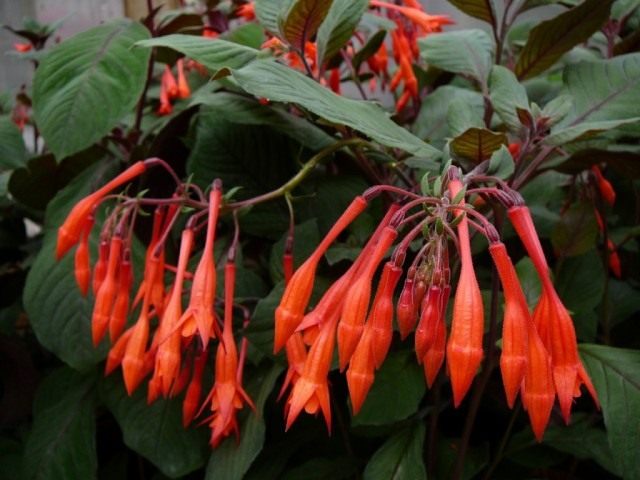 Fuchsia three-leafed. geles
Fuchsia three-leafed. geles
All of these species are bushes from 70 cm to 2.5 m in height. Branches can be strong or thin drooping. Depending on their location and strength, the plant will be compact or spreading.
Among the triphyllum hybrids and varieties of hybrid fuchsia, there are climbing ones. There are also amazing "weeping" forms with thin long (up to 2 m) shoots, very similar to the graceful wild fuchsia. Among the triphyllum hybrids, this is the 'Mantilla' cultivar.
In fuchsia, the Bolivian bush is decorated with inflorescences - clusters of long-tubular flowers at the ends of long (up to 30 cm) peduncles.
Three-leaf fuchsia flowers sit densely at the ends of the shoots. Such plants are planted in hanging baskets and balcony boxes.
 Fuchsia magellan ‘Riccartonii’. duchyofcornwall
Fuchsia magellan ‘Riccartonii’. duchyofcornwall
How to take care of it properly?
Fuchsia is an unpretentious flower, but this does not mean that you do not need to care for it at all.
It does not matter where exactly you grow the crop in question - in the garden or at home. In any case, the plant will need competent care.
Watering
When the hot summer comes, watering this plant should be done more often - at least 1 time in 3 days. Always keep a green pet under control - if the ground dries up very quickly, then you will need to water the flower in a day. When the flowering stage is completed in the fall, watering should be reduced to 1 time per week. After that, the landing can be prepared for the upcoming wintering. Watering is recommended in the morning and evening.
For irrigation, you can use only settled non-hard water at room temperature. For spraying a flower, you also need to use prepared liquids. The water should settle for at least 24 hours.

Top dressing
The culture in question, like many other decorative flowers, needs high-quality and timely fertilizing.It is necessary to choose a suitable top dressing based on the growth phase of the flower.
- Young flowers need fertilizers, which contain a large percentage of nitrogen - due to this element, the growth of shoots increases.
- Grown fuchsia prefers feeding with potassium and phosphorus content.
The frequency of top dressing depends on their immediate concentration. The standard concentration is usually applied once every 7-10 days. If fertilizer is added with each new watering, the solution should be made 3-4 times weak, at least. It is recommended to alternate mineral dressings with organic ones.
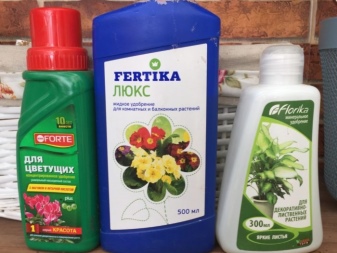
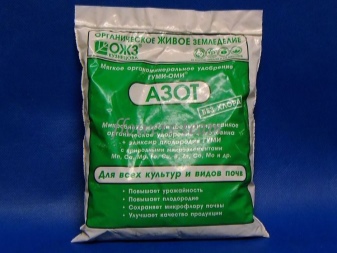
For fuchsia, the following elements will be very useful:
- nitrogen;
- potassium;
- phosphorus;
- iron;
- manganese;
- zinc;
- magnesium.
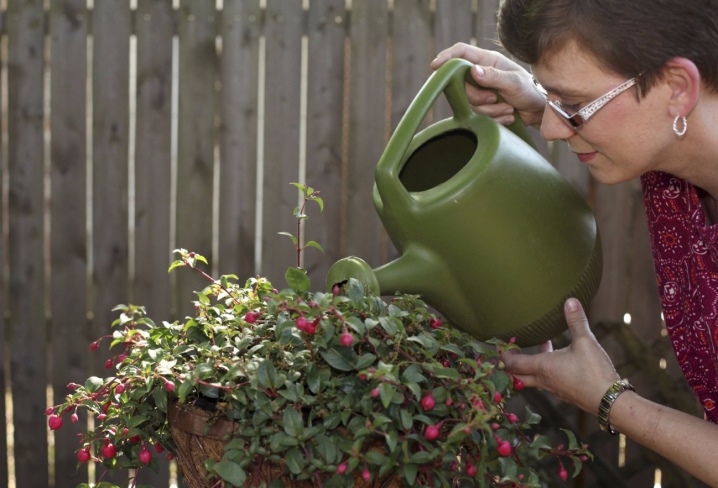
Pruning
To get a beautiful, lush and neat fuchsia bush belonging to a variety that does not branch on its own, flower growers resort to pinching, leaving the desired length of shoots. Thus, ampelous and bush forms are formed.
If it is necessary to obtain a standard shape, the seedlings are usually placed densely, breaking off all the shoots and buds formed on the sides until the desired height is reached. After that, pinching of the kidney located in the upper part is carried out.
When you need to get a nice floor-type tree, leave a stem with a height of 90 to 100 cm.To the flower can be placed on a table or a window sill, a stem 40 cm high is enough. Large trees grow for 2 years. Small specimens can be grown in just a year.
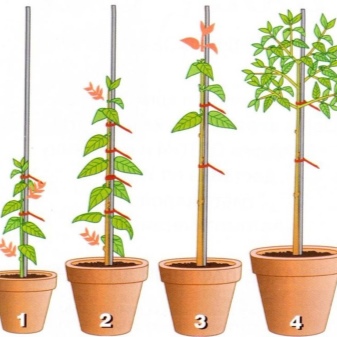
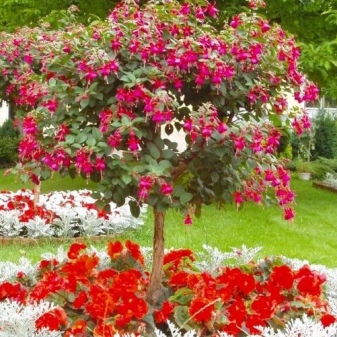
Transfer
Fuchsia transplant must be carried out observing all the rules. If the flower has enough room in the pot, and you just brought it home after purchasing, then rushing to plant the plant in a new place is not necessary. When roots are visible, then the fuchsia must be moved to a larger tank. A light container will do. Its walls effectively reflect light and protect the culture from harmful excess heat.
Subsequently, fuchsia will need to be transplanted annually. The plant must be prepared for this procedure.
It is necessary to carry out preventive and stimulating treatment. Shoots should be shortened by a third, and old, dry or overly elongated ones will need to be removed altogether.
Examine the roots for disease or rot
If there are lesions, they should be trimmed to healthy tissue.
Pay attention to the drainage layer. It should take up at least 1/5 of the pot.
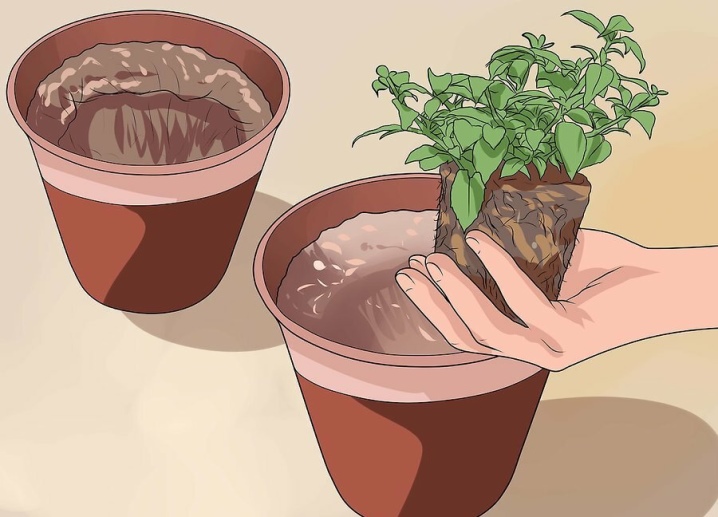
Fuchsia must be transplanted into prepared soil and a reservoir, which will be a couple of centimeters more spacious than the previous one. It is imperative to organize a drainage layer. After transplanting a green pet, you need to water and spray with settled warm water.
How to plant at home?
A purchased plant or a cut fuchsia flower stalk will take root and begin to grow, subject to planting and maintenance rules. The health of the plant depends on the selected soil and maintenance conditions.
Which pot to choose?
The size of the pot is chosen according to the age of the plant. The shoot cannot be planted in a large container, the optimal diameter is 5-7 cm.
Every year, when transplanting, the size of the pot increases by 2-3 cm. The root system of the flower should completely braid with an earthen lump. Loose soil sours, causing root rot.
Recommended material - light colored ceramic. Such a pot will not overheat in the sun. In dark plastic, the roots of the plant die under the influence of high temperature. There should be drain holes at the bottom of the container.
Soil composition
Fuchsia requires a nutritious, loose substrate with neutral acidity. We recommend a ready-made universal mixture for flowering plants. To improve the structure, disintegrants are added to the soil - perlite, vermiculite, coconut substrate.
If desired, the soil is prepared independently:
- peat, leaf humus, compost, sand in a ratio of 1: 1: 1: 2;
- leaf land: peat: sand (3: 1: 1).
A drainage layer of expanded clay or small pebbles is poured onto the bottom of the pot. It will prevent stagnant water and soil leaching.
What to do for the shoot to give roots?
The fuchsia shoot is rooted in soil or water. In order for the cutting to grow roots, it is required:
- stable warm temperature (20-22 °);
- good diffused lighting;
- high humidity (80-90%).
The required level of humidity will ensure that it is covered with a glass jar or bag. Every day, the process is ventilated, condensation is removed from the walls of the jar. The seedling is sprayed with water at room temperature. The appearance of new leaves after 2-3 weeks indicates successful rooting.
Recommendation. The lower leaves should not touch the soil so that rotting does not begin. The plant's moisture requirement is halved by trimming the remaining leaves.
Location and lighting
A fuchsia pot is placed on the east or west windows. On the north side, it provokes a weak flowering. The plant needs diffused lighting and fresh air. The best place for flowers is the balcony. During the flowering period, fuchsia cannot be touched and rearranged, it immediately drops the buds.
Temperature regime
Fuchsia tolerates coolness well, and the heat causes lethargy and drooping leaves. The optimum temperature during the growing season is 16-20 °, in winter 10-11 °. In summer, the flower is removed away from direct sunlight, which causes burns to the leaves and overheating of the roots.
Watering
Moistening a flower is the most important part of agricultural technology. Lack of water leads to drying, and overflow leads to rotting of the roots. Watering is carried out with settled water. The amount and frequency of humidification depends on the temperature in the room, the volume of the pot, and the stage of development.
The average is 100 ml per 0.5 liter pot, every 3-4 days. A little trick will allow you to determine the need for watering. A wooden stick is stuck at the edge of the pot, if it is wet and dirty, then it’s not time. If there are lumps of earth on the stick, it's time to moisturize.
Reference. Water the plant in the morning or evening, during which time the moisture is better absorbed by the roots.
Watering is partially replaced by spraying. While there are no flowers, the plant is periodically placed under the shower. In the fall, the amount of water is reduced. In winter, 1-2 waterings per month are enough.
Fertilizers
Fuchsia is a plant that requires regular feeding. A young flower needs fertilization with a high nitrogen content. An adult plant requires complete feeding with phosphorus, calcium and other trace elements. The introduction of complex fertilizers once a week will satisfy the needs of fuchsia. Foliar dressing with Bud is effective during the flowering period. Mineral products alternate with organic ones.
A good result is given by the use of long-acting fertilizers Osmocote (Osmokot). The drug is buried in the ground above the drainage layer. Minerals are contained in capsules that gradually dissolve during watering. In the spring, to stimulate the growth of shoots, they are sprayed with magnesium sulfate (1 tsp per 1 liter of water).
Fertilizers can be applied daily with watering, reducing the recommended concentration by 6 times.
It is forbidden to feed:
- diseased plants;
- seedlings that are less than 3 weeks old;
- flowers in dry soil.
Fuchsia: growing and care at home
Flower formation occurs at the ends of the shoot. It's simple - more shoots, more abundant flowering. Pinching is required to form a bush, without it it will not be possible to enhance the growth of lateral shoots. The pinching forms the branching of the flower.
Many types of fuchsia are not able to dissolve the shoots on the sides. The pinching forces to release new ones.
There are several types of pinching:
In the first case, with each new pruning, the plant has room for flower growth, the size and number of peduncles increases.
The second method - Clarke - provides faster forming compared to classic pinching. Doubles the number of shoots.
Note! Only experienced gardeners can use the latter method.Otherwise, the plant may die. What is the best time to pinch? There is no exact one, it can be both summer and winter, the main thing is that the stalk is rooted
What is the best time to pinch? There is no exact one, it can be both summer and winter, the main thing is that the cutting is rooted.
Priming
Fuchsia flower very well perceives nutritious, as well as light soil with a slightly acidic reaction and good drainage.
In theory, anyone that sells in garden stores can do. But in practice, its quality is very poor due to the fact that low-quality deliveries are possible. If you are lucky, this will be the maximum peat, which begins to shrink as it dries and cannot hold back nutrients. It also happens that a lot of garbage comes across, in which there may even be spores of mushrooms.
Coconut flower soil
There are several suitable types of fuchsia soil:
- Sand. Used to improve soil, adds weight to keep roots in the middle rather than around the perimeter. It is not recommended for use with quarry sand, as it has poor properties, for example, when it gets wet, it begins to crumble into very hard lumps. The best option would be river coarse sand or it can be replaced with finely ground clay shards.
- Peat. This is a loose rock, which is mined from an accumulation of moss residues that did not have time to decompose at very high humidity and a small amount of oxygen (mainly in swamps). Absorbs water very well. It is better to soak dried peat a day before use. The best choice is granular. It gives structure and lightness. Must be well moisturized before use.
- Turf. This is part of the topmost soil layer (approximately 11-13 cm), collected from pastures, which decomposes completely in 6-8 months. All this is due to the remains of fibers and various herbs. Sod holds water well and does not crumple.
- Leafy humus. These are leaves that have rotted over the course of the year. It can be replaced with another soil from rotten trees or peat. It has few nutrients, but it improves the quality of the soil. Reproduction on this soil is the best.
- Coconut soil. This is a new product specially designed for gardeners. It consists of the peel of a coconut, it is sold in dry form, crushed and distributed into briquettes, after the ingress of water it begins to swell strongly. Has a high moisture content, decomposition takes a long time. There is almost no way to fill this soil with water, which is very good for ampelous fuchsia. Ideally, use 50% coconut soil, cover the rest with ordinary soil. Very suitable for growing in the garden.
3 Temperature and humidity
Fuchsia care involves creating a comfortable temperature for it in the room. In summer it should be + 18 ... + 22 degrees, and in winter it should not exceed +18 degrees. If the temperature indicators for a long time are below or above these values, then the decorativeness of the plant can be severely affected. The buds will begin to fall off, the leaves will become lighter and smaller, and the fuchsia will slow down its development. The risk of damage by pests and diseases will increase.
Fuchsia grows well with an air humidity of 50-60%. Overdried indoor air leads to yellowing and wilting of plant buds and leaves. To increase the humidity, you can put a wide container of water next to the plant. In addition, the flower pot is placed in a pallet with wet expanded clay or pebbles.
In extreme heat, fuchsia should be regularly sprayed with settled water. Do this in the morning and evening. It is advisable to take it out into the fresh air in the garden or at least on the balcony. During spraying, do not allow the stream of water to hit the flowers.
Soil preparation
The first thing to look for when growing this flower is the soil. It can be purchased at the flower shop.
For fuchsias, ready-made specialized mixtures for flowering plants are suitable. They have a normal, non-acidic environment that is ideal for growing a strong and viable sprout. Experienced growers prefer to prepare the soil mixture on their own. Today there are 3 known methods:
- a mixture of peat, perlite and sand. They are needed in equal parts;
- crushed sphagnum moss, humus (preferably rotted) and vermiculite to make the soil loose. The components are mixed in equal proportions;
- a mixture of turf, peat, pine bark, sand. The components are prepared in a ratio of 3: 1: 1: 1, respectively.
Before planting, the soil must be disinfected. A weak solution (light pink) of potassium permanganate is suitable for this. During processing, thrips and nematodes are killed, and the likelihood of mold and pathogenic microflora formation is reduced. If you have a special preparation "Fitosporin", then it will successfully replace the solution of potassium permanganate.
Capacity does not play a special role in growing seedlings. Most often, plastic cups or wide containers are used. The main condition for the container is the presence of a large number of holes for water to drain. A drainage layer (2-3 cm) can be placed on the bottom of the container. For this, expanded clay or small pebbles are suitable.
Important! Liquid stagnation should not be allowed


